
Amaryllis is the only genus in the subtribe Amaryllidinae. It is a small genus of flowering bulbs, with two species. The better known of the two, Amaryllis belladonna, is a native of the Western Cape region of South Africa, particularly the rocky southwest area between the Olifants River Valley and Knysna.
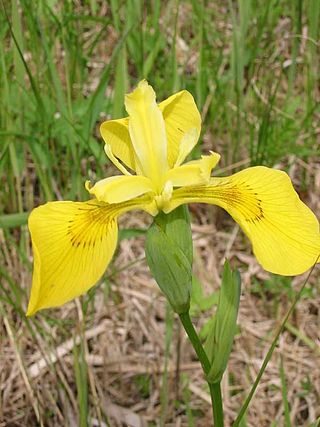
Iridaceae is a family of plants in order Asparagales, taking its name from the irises. It has a nearly global distribution, with 69 accepted genera with a total of c. 2500 species. It includes a number of economically important cultivated plants, such as species of Freesia, Gladiolus, and Crocus, as well as the crop saffron.

Gladiolus is a genus of perennial cormous flowering plants in the iris family (Iridaceae).

Babiana is a genus of geophytes in the family Iridaceae with 93 recognized species as of March 2022. The leaves consist of a stalk and a blade that are at an angle to each other. The leaf blades are entire, laterally flattened and pleated, and often hairy. Each individual flower is subtended by two hairy or smooth bracts that are green in most species. The outer bract is often the largest of the two. In most species the bracts have a dry, brown tip, but in a few species it is entirely green or entirely dry when flowering or the outer bract is translucent and has a papery texture. The inner bract is forked or split all the way to its base. Each flower is without a pedicel, with six tepals that are merged at their base into a tube and form a perianth that is mirror-symmetrical in most species, with three anthers implanted where the perianth tube widens and that are, in almost every species, clustered at one side of the style. The style has three branches that widen towards the tip and the ovary is inferior. Flowers occur in almost every conceivable colour, many have markings on some of the tepals, and few star-symmetrical flowers have a centre that strongly contrasts with the free part of the perianth. The majority of these species are endemic to the west and southwest of South Africa, and southwestern Namibia, but one species occurs elsewhere in Namibia and South Africa and another species can be found in Botswana, Namibia, South Africa, Zambia and Zimbabwe. The genus name is derived from the Dutch word baviaan, referring to the Chacma baboon, Papio ursinus, that consumes the corms of plants in the genus. The genus is called bobbejaantjie in Afrikaans, meaning small baboon.
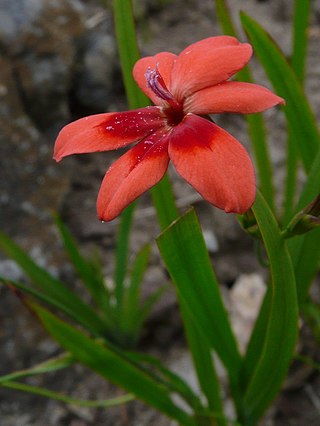
Freesia laxa, commonly known as flowering grass, is a small species of cormous flowering plant in the family Iridaceae, from eastern and southern Africa, from Kenya to northeastern South Africa. It is grown in gardens as an ornamental plant.
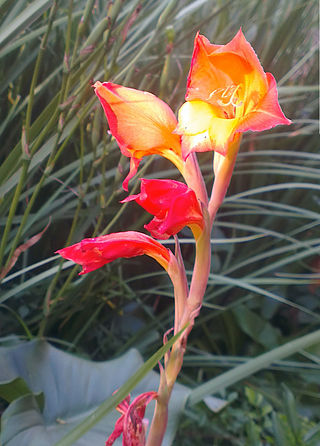
Gladiolus dalenii is a species of flowering plant in the iris family Iridaceae. It is one of the most widely distributed species of Gladiolus, ranging from eastern South Africa and Madagascar throughout tropical Africa and into western Arabia. It is the main parental species of the large flowering grandiflora hybrids. This species is also unusual in its genus in including diploid, tetraploid and hexaploid races. The hybrids produced from it are often tetraploids.

Gladiolus murielae is a species of flowering plant in the family Iridaceae, native to eastern Africa, from Ethiopia to Malawi. It has been given a number of English names, including Abyssinian gladiolus and fragrant gladiolus. It was formerly placed in the genus Acidanthera.

Leptospermum laevigatum, commonly known as the coast tea tree, is a species of shrub or small tree that is endemic to south-eastern Australia, but has been widely introduced in other places where it is often considered to be a weed. It has thin, rough bark on the older stems, narrow egg-shaped leaves, relatively large white flowers and flat topped fruit that is shed shortly after reaching maturity.

Gladiolus italicus is a species of gladiolus known by the common names Italian gladiolus, field gladiolus, and common sword-lily. It is native to much of Eurasia and North Africa, but it is well known on other continents where it is a common weed, particularly of cultivated fields and waste places. This perennial flower grows an erect stem approaching a meter in maximum height with a few long leaves around its base. Toward the top half of the generally unbranching stem is a spike inflorescence on which flowers appear at intervals. Each plant has up to 15 or 16 flowers. The flower is bright pink to magenta and several centimeters long with its stamens and style protruding from the throat. The fruit is a capsule about a centimeter long containing many seeds.

Crocoideae is one of the major subfamilies in the family Iridaceae.

Gladiolus tristis is a species of gladiolus known by several common names, including ever-flowering gladiolus and marsh Afrikaner. It is native to southern Africa, especially South Africa. It is known in parts of Australia and coastal California as an introduced species. It is sometimes grown as a garden plant. This gladiolus typically grows one half to one metre in height, but has been known to approach 1.5 metres tall. It grows from a corm one or two centimetres wide. It produces three narrow, sheathing leaves. The inflorescence is a spike of two to eight large, fragrant blooms. Each flower has six white or cream tepals with greenish or purplish midlines. The flowers are said to have a scent similar to carnations and cloves. Not all individuals possess scent because the allele for its presence is recessive in relation to the allele for its absence.
Zandvlei Estuary Nature Reserve is a 300-hectare (740-acre) nature reserve and recreational area located in Muizenberg near Cape Town, South Africa.
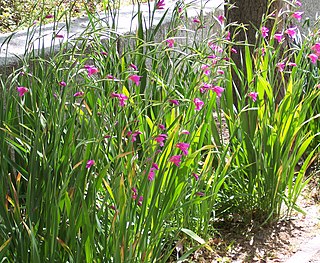
Gladiolus communis, the eastern gladiolus, or common corn-flag, is a species of flowering plant in the family Iridaceae, native to temperate northern Africa, western Asia and southern Europe, from the Mediterranean to the Caucasus, and widely naturalised in frost-free locations elsewhere – such as coastal parts of the southwestern British Isles.
Peacock flower can refer to:

Crowea angustifolia is a flowering plant in the family Rutaceae, and is endemic to the south-west of Western Australia. It is an erect shrub growing to 3 m (10 ft) high by 1.0 m (3 ft) in diameter with white or pink flowers in spring.
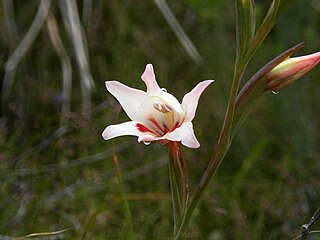
Gladiolus carneus is a plant species in the family Iridaceae.
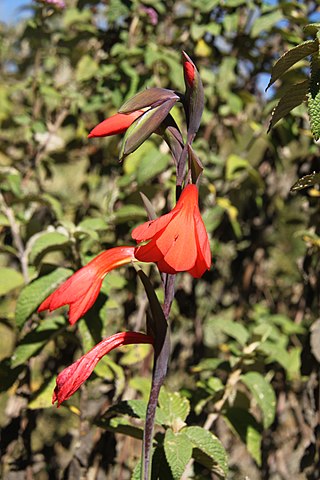
Gladiolus watsonioides is a medium to high (½–1 m), herbaceous geophyte with sword-shaped leaves, flattened in the plain of the stem, and spikes of red funnel-shaped flowers, that is assigned to the iris family. In the wild, the species is restricted to the highlands of central Kenya and northern Tanzania, including on Kilimanjaro, Mount Kenya and the Aberdare Range. It is sometimes called Mackinder's gladiolus.
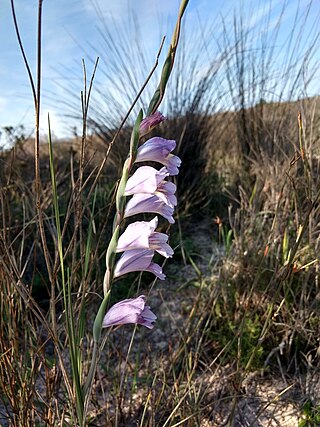
Gladiolus patersoniae is a herbaceous perennial plant belonging to the genus Gladiolus of the family Iridaceae, indigenous to the southern Cape regions of South Africa.

Babiana villosa is a species of geophyte of 10–20 cm (3.9–7.9 in) high that is assigned to the family Iridaceae. It has mauve-pink, purple or scarlet star-symmetrical wide chalice-shaped flowers with narrow tube, large, blackish or dark purple anthers, and velvety hairy, lance-shaped, laterally compressed leaves, set in a fan. Flowers occur during August and September. Its grows between Malmesbury and Wellington in the Western Cape province of South Africa. It is commonly called red babiana in English and rooibobbejaantjie in Afrikaans.

Babiana tubiflora is a species of geophyte of 7–15 cm (2.8–5.9 in) high that is assigned to the family Iridaceae. It has whitish mirror-symmetrical flowers with a long narrow tube that split into six tepal lobes, have three stamens, and line- to lance-shaped, laterally compressed leaves. It is an endemic species of South Africa that can be found along the west and south coast of the Western Cape province. It flowers from August to early October.



















